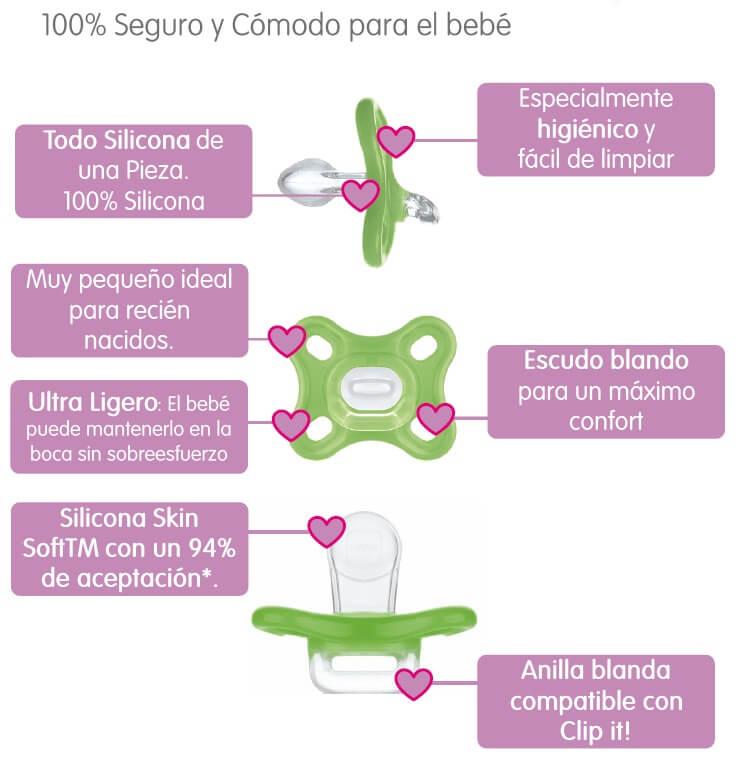What is the best pacifier for your baby?
The pacifier is one of the inseparable complements of many babies. And it is not for less, since it reduces the risk of sudden infant death syndrome (SIDS), calms pain, anxiety and crying, reduces stress and helps sleep. In addition, for those children who have not developed the sucking reflex well, the pacifier is very useful. It is also a less dangerous option for the baby than thumb sucking. They can be easily sterilized and are made of a less hard material, so the child does not get hurt, either in the mouth or on the fingers.
To this day there are still many doubts about the use of a pacifier, since, despite all its benefits, it also carries some risks. The most common associated with a pacifier are malformations in the teeth. However, according to data managed by www.dosfarma.com, the leading Spanish online pharmacy in the market, if it is abandoned before three years, there is no risk of malformation. What's more, for there to be irreversible problems in the mouth, the child should use the pacifier continuously for about six hours a day. If its use is controlled, we should not worry about it.
Other problems with the continued use of a pacifier beyond the age of three is that it increases the risk of suffering infections in the middle ear or even having difficulties pronouncing some words or sounds.
Therefore, we must remember that the pacifier is a temporary tool. The longer the baby wears it, the more difficult it will be to remove it later. After half a year of life, the risk of sudden death is greatly reduced, and before that there is almost no chance of suffering from otitis. Therefore, six months may be the ideal limit to reduce its use and prevent excessive dependence on it.
How to choose the perfect pacifier for our baby?
But how do we know which one is the safest? Or what material should it be? DosFarma experts have prepared a small guide on what to consider and how to choose the most suitable pacifier:
1. Do not use it during the first days of life

Effective breastfeeding is always the goal, and pacifier use can interfere. Therefore, it is better to incorporate it as early as the first month, when lactation is well established.
When cooking with ginger, remember: less is best. Trying to make Japanese clear soup and ....yikes. It is so spicy… https://t.co/CpW1DfuhD1
—HyperZen Creations | Crochet Commissions Open Sat May 22 06:07:30 +0000 2021
2. Choosing a safe pacifier
It is very important to buy a safe pacifier for the baby and therefore, it must comply with the standards set by the Spanish Association for Standardization and Certification (AENOR), which include minimum safety measures:
3. Choosing the most suitable type of teat
The teat is the most important element. As the baby grows, the size and type of teat must be adapted:
4. Choosing the material
They should be made of latex or silicone. Although the two options are equally valid, they have different characteristics that make them suitable for different ages:
In any case, DosFarma experts recommend that they be made in one piece, pacifiers with several pieces can break and pose a danger to children, who could swallow one of them.
5. Reserve it only for specific moments
You have to try so that the child does not depend on it and that he uses it as little as possible.
6. Having several spares
We will prevent the child from crying or getting angry for having lost his pacifier. In addition, this will make it more difficult for him to become attached to a particular one, which will make it easier to take it off when the time comes.
7. Avoid hanging it around the neck
It is dangerous to use a string or cord to hang the pacifier around the baby's neck, as there may be a risk of suffocation. If the one we buy comes with a necklace, it must be removed. A more appropriate option is the clamp, although you always have to watch that it does not come off the child's clothes and could swallow it.
8. Do not cover it with sweet substances
Although in the past many mothers have sweetened the pacifier with sugar, honey or condensed milk, this does not mean that it is well made, since it greatly increases the risk of suffering future cavities, in addition of not favoring the development of the sense of taste.
9. Always keep it clean
We must always make sure that the pacifier is clean before giving it to the baby. It is best to boil it or wash it in the dishwasher if the child is under six months, since their immune system is still in formation. From seven months it can be washed well with soap and water.
10. Change it regularly
Not only because it can break and spoil, but because you have to adapt it to the needs of the baby. Normally, the ideal is to change it every month and a half or two months.
Clara Motos, DosFarma pharmacist, comments: "Although there are still many doubts about the use of pacifiers, in general, if you buy a quality one (putting aesthetics second) and that meets all safety requirements , there is no problem in our baby using it. However, you should not depend on it and the ideal is to stop using it before the age of three. For this reason, it is best not to use it too often and not get the child used to using it if he doesn't miss it. At DosFarma we wanted to prepare a small guide so that all parents know how to choose the safest and most suitable pacifier for their children and that they can take advantage of all the benefits it provides".










Related Articles